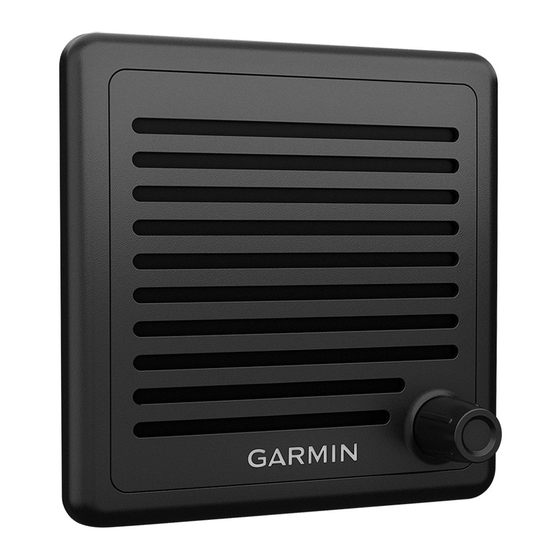Garmin VHF 315 Series Manuel du propriétaire - Page 25
Parcourez en ligne ou téléchargez le pdf Manuel du propriétaire pour {nom_de_la_catégorie} Garmin VHF 315 Series. Garmin VHF 315 Series 32 pages.
Également pour Garmin VHF 315 Series : Manuel d'instructions d'installation (6 pages), Manuel d'instructions d'installation (15 pages)

When you connect the radio to a NMEA 0183 device or a NMEA 2000 network, you can transfer received DSC
distress and position information to any compatible connected chartplotter
The radio can also receive GPS-position information from a NMEA 0183 device or a NMEA 2000 network.
Received GPS-position information appears on the home screen and is transmitted with DSC calls.
on the screen when GPS data is available, and flashes when GPS data is not present. When GPS data is not
present, you must enter your position manually
For more information on connecting the radio to a NMEA 0183 device or a NMEA 2000 network, see the
Installation Instructions.
Additional Functionality with Other Garmin Devices
The radio has additional capabilities when you connect it to other Garmin devices, such as a chartplotter.
NOTE: You may need to upgrade your Garmin chartplotter software to use NMEA 0183 or NMEA 2000 features.
When you connect the radio to a Garmin chartplotter using either NMEA 0183 or NMEA 2000, your chartplotter
keeps track of the current and previous positions of the contacts in the directory.
When you connect the radio to the same NMEA 2000 network as a Garmin chartplotter, you can use the
chartplotter to set up an individual routine call.
When you connect the radio to the same NMEA 2000 network as a Garmin chartplotter, and you initiate a man-
overboard distress call from the radio, the chartplotter prompts you to navigate to the man-overboard location.
If you connect a Garmin autopilot system to the same NMEA 2000 network, the chartplotter prompts you to
start a Williamson's turn to the man-overboard location.
Communicating Over NMEA 0183 or NMEA 2000
NOTE: This feature is not available on all models.
You can select a connection either to a NMEA 0183 device or to a NMEA 2000 network. The radio can
communicate over only one communication protocol at a time.
1 Select MENU > COMMUNICATIONS > PROTOCOL.
2 Select NMEA0183 or NMEA2000.
Configuring DSC NMEA Transmissions
You can filter the types of DSC-call data the radio sends to a connected NMEA 0183 device or over a NMEA
2000 network.
1 Select MENU > COMMUNICATIONS > DSC OUTPUT.
2 Select an option:
• To send NMEA data when you receive a DSC call from any MMSI number, select ALL VESSELS, and
proceed to the last step.
• To disable sending NMEA data when you receive a DSC call, select NO VESSELS, and proceed to the last
step.
• To send NMEA data only when you receive a call from a vessel in your directory, select SELECT VESSELS,
and proceed to the next step.
NOTE: When you configure the radio for SELECT VESSELS, all received DSC-distress-call data is sent over
NMEA, even if the vessel is not in your directory.
3 Select a vessel in your directory.
4 Select an option:
• To send all DSC-call data from this vessel, select ON.
• To send DSC-distress-call data only from this vessel, select OFF.
5 Repeat this process for each vessel in your directory.
6 Select BACK to save your changes and exit the menu.
NMEA 0183 and NMEA 2000
®
NMEA 0183 and NMEA 2000
(Manual Position Information, page
®
(NMEA, page
24).
19).
appears
21
